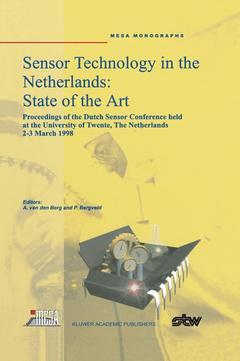Description
Sensor Technology in the Netherlands: State of the Art, Softcover reprint of the original 1st ed. 1998
Proceedings of the Dutch Sensor Conference held at the University of Twente, The Netherlands, 2-3 March 1998
Coordinators: Berg Albert van den, Bergveld Piet
Language: English
Subject for Sensor Technology in the Netherlands: State of the Art:
Publication date: 11-2012
325 p. · 16x24 cm · Paperback
325 p. · 16x24 cm · Paperback
Description
/li>Contents
/li>Comment
/li>
In the rapidly developing information society there is an ever-growing demand for information-supplying elements or sensors. The technology to fabricate such sensors has grown in the past few decades from a skilful activity to a mature area of scientific research and technological development. In this process, the use of silicon-based techniques has appeared to be of crucial importance, as it introduced standardized (mass) fabrication techniques, created the possibility of integrated electronics, allowed for new transduction principles, and enabled the realization of micromechanical structures for sensing or actuation. Such micromechanical structures are particularly well-suited to realize complex microsystems that improve the performance of individual sensors. Currently, a variety of sensor areas ranging from optical to magnetic and from micromechanical to (bio)chemical sensors has reached a high level of sophistication.
In this MESA Monograph the proceedings of the Dutch Sensor Conference, an initiative of the Technology Foundation (STW), held at the University of Twente on March 2-3, 1998, are compiled. It comprises all the oral and poster contributions of the conference, and gives an excellent overview of the state of the art of Dutch sensor research and development. Apart from Dutch work, the contributions of two external invited experts from Switzerland are included.
In this MESA Monograph the proceedings of the Dutch Sensor Conference, an initiative of the Technology Foundation (STW), held at the University of Twente on March 2-3, 1998, are compiled. It comprises all the oral and poster contributions of the conference, and gives an excellent overview of the state of the art of Dutch sensor research and development. Apart from Dutch work, the contributions of two external invited experts from Switzerland are included.
Measurement Strategies for Object Identification; P.P.L. Regtien. A Smart 2.5D Image Sensor Containing a PSD Array and an On-Chip Multiplexer; M. de Bakker, et al. Adaptive Optical System Based on a Micromachined Adaptive Mirror; G. Vdovin, S. Sakarya. The Integrated Compass Watch Microsystem; R.J.W.T. Tangelder, H.G. Kerkhoff. Non-Destructive Food-Sterility and Package-Quality Testing of Aseptically Packed Food Products by Impedance Measurements; S.N. Nihtianov, G.C.M. Meijer. Transduction Principles and Integration of Chemical Sensors into a Micromechanical Array Device; R. Berger, et al. Measurement on Single DNA Molecules; B.G. de Grooth, et al. Novel Integrated Optical Refractometer; G.J. Veldhuis, P.V. Lambeck. Temperature Dependence of a Thermal Accelerometer; U.A. Dauderstädt, et al. Nearly Quantum-Limited Squids for a Gravitational Wave Antenna; J. Flokstra, et al. From Biosensors to Biosensing Systems; E. Verpoorte. Glass Channels and Capillary Injectors for Capillary Zone Electrophoresis; Y. Fintschenko, et al. A New Fabrication Method for In-Plane Micro Fluid Handling Components and Analysis Systems; R.E. Oosterbroek, et al. A System for Fluid Dosing in the Nanoliter Range; S. Böhm, et al. Chemically Modified Field-Effect Transistors for Measurement of Ion Activities in Aqueous Solution; M.M.G. Antonisse, et al. Selective Optode Membranes for Heavy Metal Ion Detection; N.J. van der Veen, et al. Covalent Coupling of Polyamines to Aminobead-Covered ISFETs; G. Besselink, et al. DNA Binding Kinetics of Oct-1 Linker Mutant Proteins Studied with the Instrument for Biomolecular Interaction Sensing (IBIS); H.C. van Leeuwen, et al. Entrepreneurship in Sensor-Land; S. Middelhoek. A Novel Concept in Thin Film MagneticHeads: The Sensor Last Design; A.H. van Heeren, et al. Membrane Fabrication with Galvanic Etch-Stop; C.M.A. Ashruf, et al. Fabrication Technology of Geiger Mode Avalanche Photodiodes; W.J. Kindt, H.W. van Zeijl. Dry Release of Metal Structures in Oxygen Plasma; M. Bartek, et al. Miniaturized ISFET Interface for the Use on a Serial PC Port; G.R. Langereis, et al. A Low Power Detection Method for Small Ultrasonic Echo Signals; E.A. Dijkstra, et al. Design of a Smart Microacoustic Liquid Sensor System &endash; Part I: Microacoustic Device; B. Jakoby, et al. Design of a Smart Microacoustic Liquid Sensor System &endash; Part II: Electronics; G.W. Lubking, et al. Influence of Substrate Voltage on Sensitivity and Offset of (Spinning-Current) Hall Plates; S. Bellekom. Hybrid Integrated Electro-Optic Sensor Platform; A.J.T. de Krijger, et al. A Theoretical and Experimental Study of the Piezo-Junction Effect in Silicon and its Exploitation in New Sensor Structures; F. Fruett, et al. Sacrificial Oxide Etching Compatible with Aluminium Metallization; P.T.J. Gennissen, P.J. French. Free Standing Beams Made by Single Step Electrochemical Etching in Hydrofluoric Acid; H. Ohji, et al. Development of a Disposable Biosensor Chipcard System; G. Dirks, et al. Quartz-to-Silicon Fusion Bonding for Micro Acoustic Wave Applications; A. Berthold, et al. Cyclodextrins as Receptors on Surface Acoustic Wave Devices; H.F.M. Nelissen, et al. A Low-Cos Smart Interface for Active Sensors; X. Li, G.C.M. Meijer. Smart Optical Sensor Systems in CMOS for Measuring Light Intensity and Colour; G. de Graaf, R.F. Wolffenbuttel. Thermal Analysis of Multi-Chip-Composed Microsystem; M.P. Brünner, et al. IC Post-Processing Module for Deposition of Thin Metal Films
In the rapidly developing information society there is an ever-growing demand for information-supplying elements or sensors. The technology to fabricate such sensors has grown in the past few decades from a skilful activity to a mature area of scientific research and technological development. In this process, the use of silicon-based techniques has appeared to be of crucial importance, as it introduced standardized (mass) fabrication techniques, created the possibility of integrated electronics, allowed for new transduction principles, and enabled the realization of micromechanical structures for sensing or actuation. Such micromechanical structures are particularly well-suited to realize complex microsystems that improve the performance of individual sensors. Currently, a variety of sens
© 2024 LAVOISIER S.A.S.




